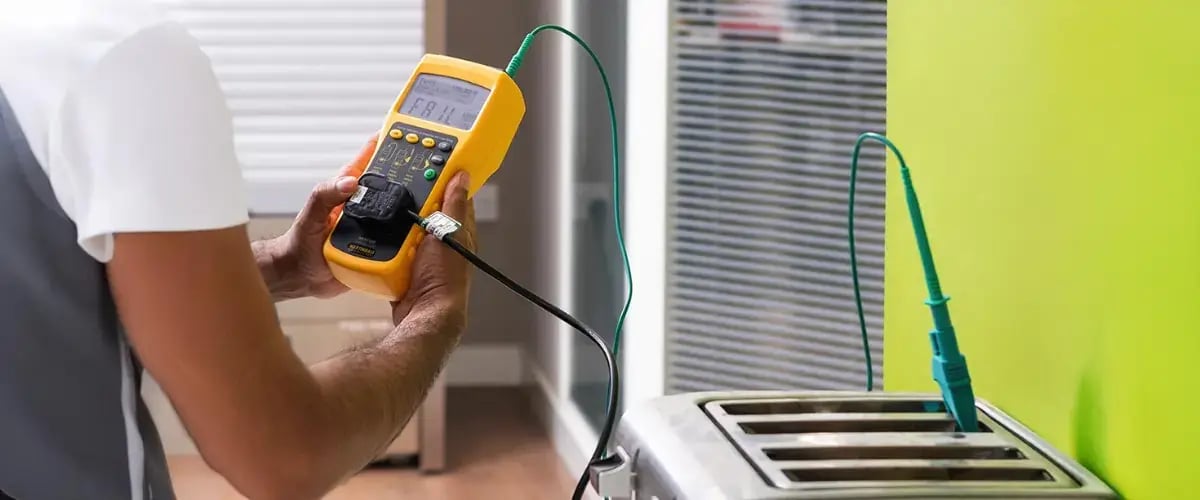What is the Legal Requirement for Pat Testing?
by Team Tradify, February 24, 2025

Table of Contents
While there are no direct legal requirements for PAT testing, there are laws dictating the rules for keeping staff, customers and visitors safe from electrical shocks and fires. These differ across the United Kingdom, Australia, New Zealand and the United States. However, their main purpose is to provide proof that a business is doing what it can to ensure its portable electrical equipment is functional and safe.
Check your staff is up to date on Health & Safety requirements with our free checklist
Low on time? Skip ahead!- What is a PAT test?
- How often should a PAT test be done?
- United Kingdom – Workplace electrical safety
- Australia – Test and Tag
- New Zealand – Test and Tag
- United States – Workplace electrical safety
1. What is a PAT test?
A PAT test is a process where a trained individual inspects and tests electrical appliances to ensure they meet safety standards. It begins by checking for visible damage, such as frayed cords, faulty connections, or broken covers. If the appliance appears safe, a Portable Appliance Tester assesses its insulation, earthing, and polarity. Once testing is complete, the appliance is labelled with a tag confirming it has been tested. This tag must include the technician’s name, the test date, and the next scheduled inspection date.
Technicians performing PAT tests must be trained in using a Portable Appliance Tester and have a solid understanding of electrical hazards and the types of appliances they may encounter. A formal certification is highly recommended to ensure they comply with local regulations.
2. How often should a PAT test be done?
A PAT test is used to ensure that portable electrical devices are safe to use. This works to keep their records up to date, which is particularly important should they need to file an insurance claim related to a faulty electrical appliance. Therefore, any equipment which has a high usage should be tested regularly.
That being said, on average, a typical office or shop will perform a PAT test for all their appliances once a year.
Industrial sites, including commercial kitchens, ideally have their portable and handheld equipment tested as often as every 6 months. For other stationary, movable or IT equipment, it is recommended to test every 12 months.
For construction sites, or any workplace where portable electrical tools are exposed to the elements, this is much more frequent and can be as often as every 3 months. This is because tools and equipment are exposed to extreme wear and tear, dust, moisture, and rough handling—all of which increase the risk of faults, damage, and electrical hazards.
3. United Kingdom – Workplace electrical safety
In the UK, several laws outline the need for maintaining safe electrical equipment at work. Using a registered electrician to perform a PAT test is widely accepted as the best way to comply with these requirements:
- Health and Safety at Work Act 1974 — This law dictates that employers must provide a safe working environment, including providing proof of electrical safety.
- Electricity at Work Regulations 1989 — All electrical systems must be properly maintained to prevent hazards.
- Provision and Use of Work Equipment Regulations (PUWER) 1998 — This states that all work equipment, including portable appliances, must be kept in a safe condition.
- Management of Health & Safety at Work Regulations 1999 — Employers must assess and manage risks, including electrical hazards.
- Housing Act 2004 — Landlords and property managers must ensure that residential properties maintain safe electrical standards, as determined by a licensed electrician.
- The Electrical Safety Standards in the Private Rented Sector (England) Regulations 2020 — This law dictates that any private individual or body ensures that the electrical installations in their rental properties are inspected and tested at least every five years by a qualified and competent person.
Looking for a digital PAT report? Create, sign, and send digital Portable Appliance Testing Reports from any device with Tradify.
4. Australia – Test and Tag
In Australia, PAT testing is commonly referred to as Test and Tag. They're widely expected under workplace safety regulations, in every industry, under the following laws:
- Work Health and Safety (WHS) Act 2011 — Employers must ensure all electrical equipment in the workplace is safe. Check page 17 of the legislation for more details.
- AS/NZS 3760:2022 Standard — This standard sets the guidelines for:
- How often appliances need to be tested by industry
- Inspection and electrical testing procedures
- Labelling and record-keeping requirements
- Electrical Equipment Safety System (EESS) — This ensures electrical products sold in Australia meet safety standards before being used. Electricians are often brought in to verify that electrical equipment is properly certified and registered under the EESS before installation.
5. New Zealand – Test and Tag
New Zealand follows a similar Test and Tag system to Australia. However, the laws they align with are:
- Electricity (Safety) Regulations 2010 — This dictates that all electrical appliances used in workplaces must be safe.
- AS/NZS 3760:2022 Standard — This is the same standard that is used in Australia. It sets out the requirements for inspection, testing, and tagging of electrical equipment.
6. United States – Workplace electrical safety
Unlike the UK, Australia, and New Zealand, the United States does not have a formal PAT testing requirement. However, there are laws ensuring electrical safety in workplaces. These are:
- OSHA Electrical Safety Standards — Every business in the US must comply with OSHA requirements. This states that employers must ensure all electrical equipment is hazard-free and properly maintained.
- National Electrical Code (NEC) — The NEC provides national guidelines for electrical installations and workplace safety. Compliance with NEC standards is enforced at both state and local levels.
Looking for more help? Check out our guides on:
- The Best Portable Appliance Testers
- Portable Appliance Testing Report Certificate
- Who Can Test and Tag Electrical Equipment?
- Electrical Health & Safety - What You Need to Know
- Emergency Lighting Inspection & Test Certificates
- Digital Electrical Safety Certificates
With Tradify, you can:
Access and auto-fill a huge range of electrical certificates, as well as manage your:Looking for business software to run your business? Try Tradify free for 14 days, or pop into one of our free demos.
Related articles

Quick Quotes Mean More Jobs for Sharp Air Conditioning

How To Set Up a Google Business Profile (for Trade Businesses)

Aussie Electrician Reduces Admin Time by 95%
Give Tradify a go for free!
Save 10+ hours/week on business admin with the highest-rated job management software for tradespeople.
With free one-on-one training and phone support, it's never been easier to get started.





